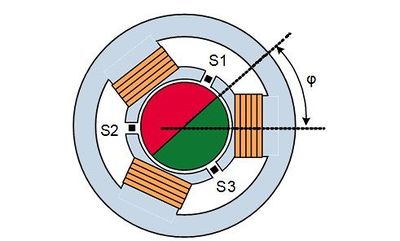Phasing a.k.a. phase search
Unlike DC motors, AC & BLDC & linear motors (synchronous motors) require electrical commutation. This means that sinusoidal waveforms fed to windings (stator) must all times run in synchronism with motor magnets (rotor). As rotor is the moving part, drive must track it's motion in order to commutate current to correct winding phases.
Suggested reading How Brushless Motors Work.
Phasing methods
Normally optimal angle difference between the magnetic field generated by windings and magnets is 90 degrees. So to keep commutation angle at 90 degrees, drive must first know the initial position of rotor. After power-up of drive, drive does not know the angle of rotor and it must be found out before starting servo control. This can be usually achieved by using one of the following methods:
- By driving current to windings and letting motor to settle to certain magnetic angle
- By utilizing absolute feedback device, such as Hall sensors or resolver, to give all needed information directly
The first method induces small motion during drive power-up as windings pull nearest magnets towards them. The maximum amount of motion is +/-90 degrees of magnetic pitch, i.e. for 4 pole motors the physical motion angle stays within +/-45 degrees from the initial angle. This method typically consumes few seconds of time before motor is operational. This method has pros and cons:
- Pros
- No any kind of absolute position sensor needed (i.e. Hall sensors)
- Less wiring
- Works with all motors
- Cons
- Motor needs to move freely in both directions from the start position
- External conditions may lead to imperfect phase angle which leads to reduction of torque or servo stability. Such conditions are:
- High torque applied to motor while phasing is in progress (such as vertical axis)
- Blocked motion (motor can't freely rotate)
The second method gives the needed magnetic angle info directly to drive and no motion is needed to determine the rotor angle. This method allows instant power-up of motor without any induced motion or delay.
- Pros
- Instant power up of motor
- No motion from start position needed
- Insensitive to external conditions
- Cons
- More wiring and more parts that may malfunction
- Not well standardized in industry (hall sensors may not be similarly aligned in different motors, causing difficulties when utilizing them with servo drive)
In no event the Product Information or parts hereof shall be regarded as guarantee of conditions or characteristics. The Product Information or any part thereof may also not be regarded as a warranty of any kind. No liability of any kind shall be assumed by Author with respect to Product Information or any use made by you thereof, nor shall Author indemnify you against or be liable for any third party claims with respect to such information or any use thereof.
As content of this Wiki may be edited by user community, Granite Devices Oy or it's affiliates do not take any responsibility of the contents of this Wiki. Use information at your own risk. However, Granite Devices staff attempts to review all changes made to this Wiki and keep information trustworthy.
Without written consent, Granite Devices' Products or Intellectual Property shall not be used in situations or installations where living beings, material property, or immaterial property could be harmed by the operation, features or failures of Product. Products may only be used in a way where hazards like moving parts, electric shock, laser radiation, or fire can't be realized even if the content of this Wiki would suggest otherwise.
